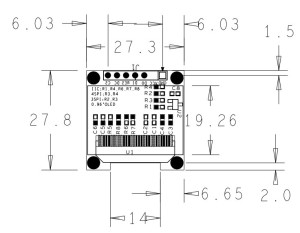#define OLED_DC 11 // DC define at Arduino Pin 11
#define OLED_CS 12 // CD define at Arduino Pin 12
#define OLED_CLK 10 // CLK define at Arduino Pin 10
#define OLED_MOSI 9 // MOSI define at Arduino Pin 9
#define OLED_RESET 13 // RST define at Arduino Pin 13
#include <SSD1306.h> // SSD1306 Code Library
SSD1306 oled(OLED_MOSI, OLED_CLK, OLED_DC, OLED_RESET, OLED_CS);
#define NUMFLAKES 10
#define XPOS 0
#define YPOS 1
#define DELTAY 2
#define LOGO16_GLCD_HEIGHT 16
#define LOGO16_GLCD_WIDTH 16
static unsigned char __attribute__ ((progmem)) logo16_glcd_bmp[]={
0x30, 0xf0, 0xf0, 0xf0, 0xf0, 0x30, 0xf8, 0xbe, 0x9f, 0xff, 0xf8, 0xc0, 0xc0, 0xc0, 0x80, 0x00,
0x20, 0x3c, 0x3f, 0x3f, 0x1f, 0x19, 0x1f, 0x7b, 0xfb, 0xfe, 0xfe, 0x07, 0x07, 0x07, 0x03, 0x00, };
void setup() {
Serial.begin(9600);
// If you want to provide external 7-9V VCC, uncomment next line and comment the one after
//oled.ssd1306_init(SSD1306_EXTERNALVCC);
// by default, we'll generate the high voltage from the 3.3v line internally! (neat!)
oled.ssd1306_init(SSD1306_SWITCHCAPVCC);
// init done
oled.display(); // show splashscreen
delay(2000);
oled.clear(); // clears the screen and buffer
// Fill Oled screen
oled.fillrect(0, 0, SSD1306_LCDWIDTH-1, SSD1306_LCDHEIGHT-1, WHITE);
oled.display();
delay(2000);
// Set to draw a single pixel
oled.setpixel(10, 10, WHITE);
oled.display();
delay(2000);
oled.clear();
// Set to draw many lines
testdrawline();
oled.display();
delay(2000);
oled.clear();
//Set to draw rectangles
testdrawrect();
oled.display();
delay(2000);
oled.clear();
//Set to draw multiple rectangles
testfillrect();
oled.display();
delay(2000);
oled.clear();
//Set to draw mulitple circles
testdrawcircle();
oled.display();
delay(2000);
oled.clear();
//Set to draw a white circle, 10 pixel radius, at location (32,32)
oled.fillcircle(32, 32, 10, WHITE);
oled.display();
delay(2000);
oled.clear();
//Set to draw the first ~12 characters in the font
testdrawchar();
oled.display();
delay(2000);
oled.clear();
//Set to draw a string at location (0,0)
oled.drawstring(0, 0, "Lorem ipsum dolor sit amet, consectetur adipisicing elit, sed do eiusmod tempor incididunt ut labore et dolore magna aliqua. Ut enim ad minim veniam, quis nostrud exercitation");
oled.display();
delay(2000);
oled.clear();
//Set to miniature bitmap display
oled.drawbitmap(30, 16, logo16_glcd_bmp, 16, 16, 1);
oled.display();
//Set to invert the display
oled.ssd1306_command(SSD1306_INVERTDISPLAY);
delay(1000);
oled.ssd1306_command(SSD1306_NORMALDISPLAY);
delay(1000);
//Set to draw a bitmap icon and 'animate' movement
testdrawbitmap(logo16_glcd_bmp, LOGO16_GLCD_HEIGHT, LOGO16_GLCD_WIDTH);
}
// loop all the function above
void loop()
{
for (uint8_t i=0; i<SSD1306_LCDWIDTH; i++) {
for (uint8_t j=0; j<SSD1306_LCDHEIGHT; j++) {
oled.setpixel(i, j, WHITE);
oled.display();
}
}
}
void testdrawbitmap(const uint8_t *bitmap, uint8_t w, uint8_t h) {
uint8_t icons[NUMFLAKES][3];
srandom(666); // whatever seed
// initialize the display
for (uint8_t f=0; f< NUMFLAKES; f++) {
icons[f][XPOS] = random() % SSD1306_LCDWIDTH;
icons[f][YPOS] = 0;
icons[f][DELTAY] = random() % 5 + 1;
Serial.print("x: ");
Serial.print(icons[f][XPOS], DEC);
Serial.print(" y: ");
Serial.print(icons[f][YPOS], DEC);
Serial.print(" dy: ");
Serial.println(icons[f][DELTAY], DEC);
}
while (1) {
//Set to draw each icon
for (uint8_t f=0; f< NUMFLAKES; f++) {
oled.drawbitmap(icons[f][XPOS], icons[f][YPOS], logo16_glcd_bmp, w, h, WHITE);
}
oled.display();
delay(200);
// then erase it + move it
for (uint8_t f=0; f< NUMFLAKES; f++) {
oled.drawbitmap(icons[f][XPOS], icons[f][YPOS], logo16_glcd_bmp, w, h, BLACK);
// move it
icons[f][YPOS] += icons[f][DELTAY];
// if its gone, reinit
if (icons[f][YPOS] > SSD1306_LCDHEIGHT) {
icons[f][XPOS] = random() % SSD1306_LCDWIDTH;
icons[f][YPOS] = 0;
icons[f][DELTAY] = random() % 5 + 1;
}
}
}
}
void testdrawchar(void) {
for (uint8_t i=0; i < 168; i++) {
oled.drawchar((i % 21) * 6, i/21, i);
}
}
void testdrawcircle(void) {
for (uint8_t i=0; i<SSD1306_LCDHEIGHT; i+=2) {
oled.drawcircle(63, 31, i, WHITE);
}
}
void testdrawrect(void) {
for (uint8_t i=0; i<SSD1306_LCDHEIGHT; i+=2) {
oled.drawrect(i, i, SSD1306_LCDWIDTH-i, SSD1306_LCDHEIGHT-i, WHITE);
}
}
void testfillrect(void) {
for (uint8_t i=0; i<SSD1306_LCDHEIGHT; i++) {
// alternate colors for moire effect
oled.fillrect(i, i, SSD1306_LCDWIDTH-i, SSD1306_LCDHEIGHT-i, i%2);
}
}
void testdrawline() {
for (uint8_t i=0; i<SSD1306_LCDWIDTH; i+=4) {
oled.drawline(0, 0, i, SSD1306_LCDHEIGHT-1, WHITE);
oled.display();
}
for (uint8_t i=0; i<SSD1306_LCDHEIGHT; i+=4) {
oled.drawline(0, 0, SSD1306_LCDWIDTH-1, i, WHITE);
oled.display();
}
delay(1000);
for (uint8_t i=0; i<SSD1306_LCDWIDTH; i+=4) {
oled.drawline(i, SSD1306_LCDHEIGHT-1, 0, 0, BLACK);
oled.display();
}
for (uint8_t i=0; i<SSD1306_LCDHEIGHT; i+=4) {
oled.drawline(SSD1306_LCDWIDTH - 1, i, 0, 0, BLACK);
oled.display();
}
}







